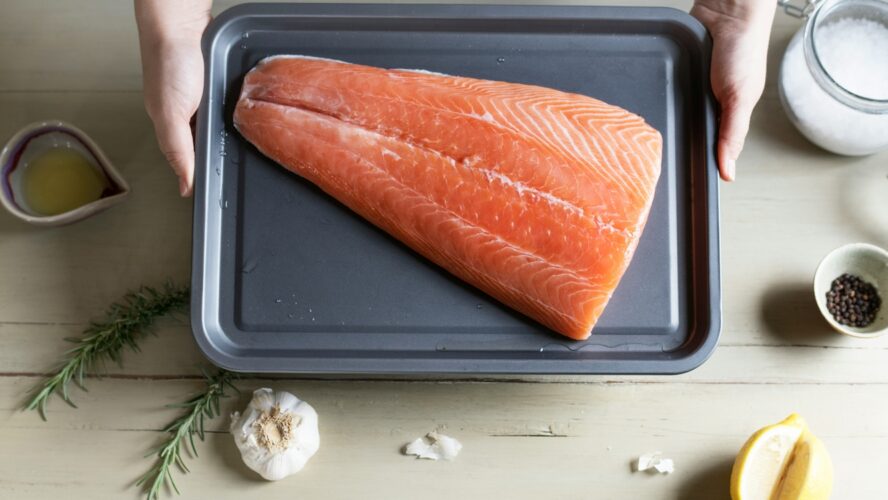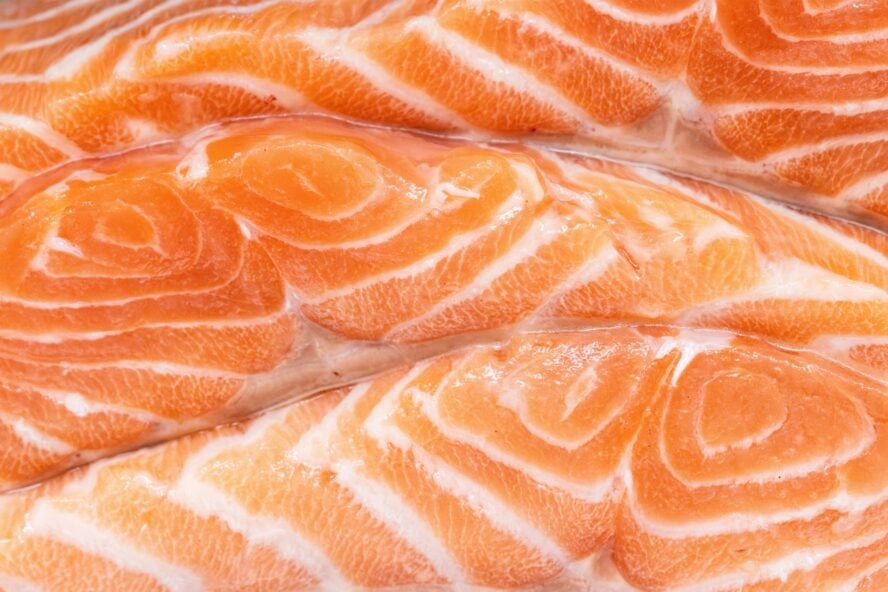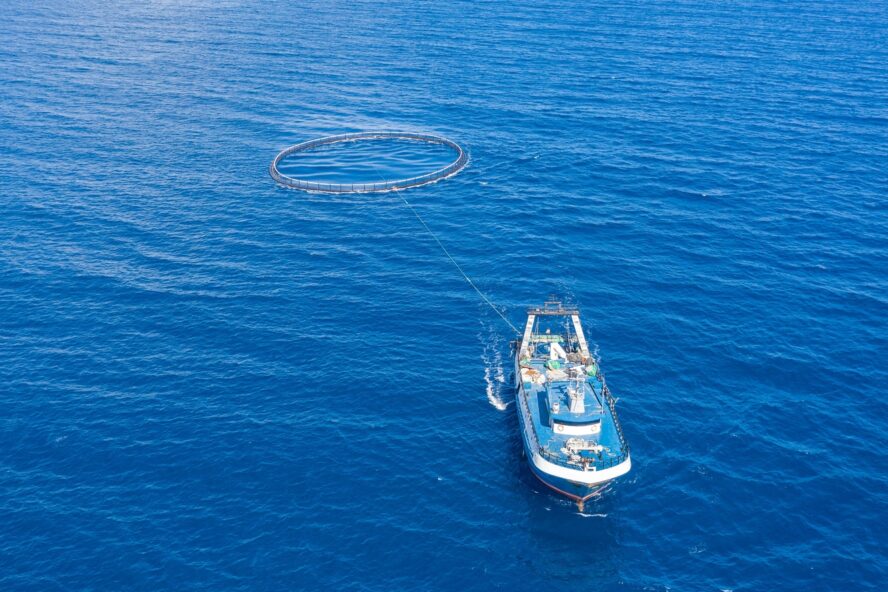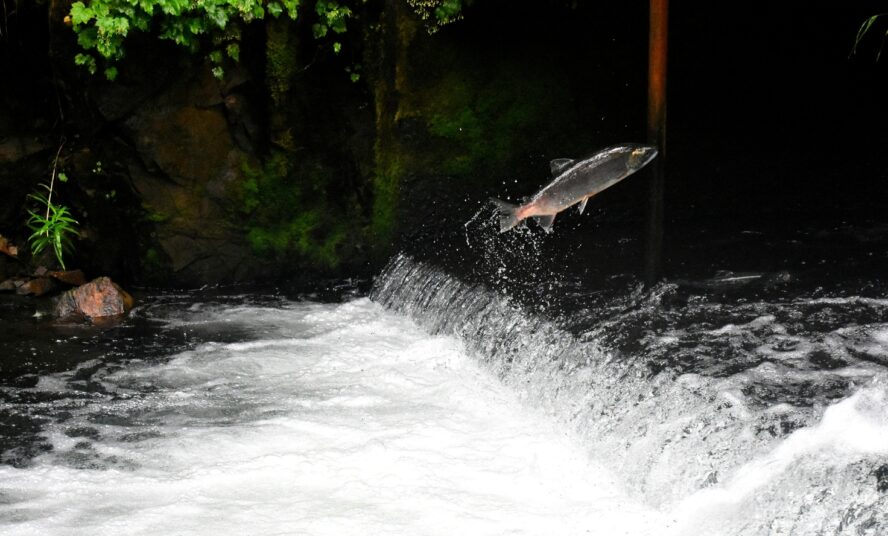
Salmon is one of the most popular fish in the U.S., and it’s not hard to see why. With its silky, buttery flesh rich in heart-healthy omega-3 acids, salmon is a delicious and smart addition to any diet. It should come as no surprise, then, that in the past 30 years, salmon’s popularity has soared: The worldwide salmon market has increased from 500,000 tons to 3 million1, and the average American eats more than three pounds of salmon each year.
But while this habit may be heart-healthy, it isn’t necessarily the most sustainable choice. Many salmon populations are severely overfished, and compounded with the effects of climate change warming the rivers salmon navigate to spawn2, there is a major scarcity in the wild salmon department. Enter farmed salmon — a solution that has solved some problems and caused even more.
Want more heatlh and wellness news? Sign up for the newsletter for more well-researched, non-toxic living guidance and smart wellness advice.
The Introduction of Farm-Raised Salmon
America’s first salmon farms were first established in the ‘70s, and these days, more than 70 percent of the salmon we eat is farm-raised3. But salmon farms, which are typically suspended in the open ocean, have the potential to be an environmental blight. The factory farm conditions afflicting land farming are just as applicable to aquaculture (think the GMO salmon experiment), and less-than-ideal conditions mean these farms pollute the ocean with antibiotics, hormones, waste, and illness.
While strides have been made in recent years to improve the environmental footprint of salmon aquaculture, the waters are still sometimes murky when it comes to deciding between wild-caught salmon vs. and farmed-raised. So how do you choose? Here’s a breakdown of what to consider.
Flavor of Wild vs. Farmed Salmon
Many point to flavor as the core factor in their decision on wild vs. farmed salmon. And there is definitely a difference — but it might not be what you expect. A blind taste test conducted by the University of Copenhagen in 2021 showed that consumers actually prefer the farmed stuff4.
Wild-caught salmon tends to have a more robust flavor than farmed, which tends to be milder and more buttery. Ultimately, the winner in the flavor battle of farmed vs. wild salmon comes down to preference. If you like fattier, more luxurious salmon, you’ll likely prefer farmed; if your palette leans towards a fishier taste, wild salmon is your best bet.
Health Benefits of Wild vs. Farmed Salmon

Another reason that some might choose wild salmon over farmed has to do with the health benefits. While both wild and farmed salmon contain the heart-healthy omega-3s that have the potential to guard against cognitive decline5, depression6, cardiovascular disease7, and even cancer8, 2020 research in Food found that wild salmon has a better balance of omega-3 to omega-6 fatty acids9.
But is farmed salmon unhealthy? On the contrary — experts say this difference is minor when it comes to searching for the most nutritious salmon. A 2014 study showed that consumption of farmed salmon still did indeed modify plasma levels of both omega-3 and omega-6 fatty acids at levels associated with a decreased risk of cardiovascular disease10.
As Stefanie Colombo, an associate professor in aquaculture nutrition at Dalhousie University in Canada, told the New York Times, “there’s not much difference between wild and farmed” from a nutritional perspective11. Her research found that while wild sockeye and wild chinook were the most nutrient-dense, farmed Atlantic salmon only had slightly lower levels of healthful nutrients, and wild Pacific salmon had even less12.
Contaminants in Wild vs. Farmed Salmon
When it comes to mercury and other contaminants, farmed salmon is better for you than wild. According to Colombo’s research, farmed Atlantic salmon had lower mercury levels than wild-caught varieties. But even in the case of wild Atlantic salmon, contaminant concentrations are “well below” maximum approved EU levels13.
At the end of the day, the difference in health benefits between farmed vs. wild salmon is negligible enough that it shouldn’t be a major factor in your choice.
Environmental Impact of Salmon: Wild vs. Farmed
Neither wild nor farmed salmon is perfect when it comes to environmental impact. Many salmon fisheries are severely overfished — of the 127 varieties of salmon Seafood Watch covers, only 39 are certified as sustainable14. But while food journalist Mark Bittman says that “community aquaculture has been practiced sustainably for centuries, from the traditional fishponds of Hawai’i, to the oyster beds of the Romans,” the modern approach is anything but.
Most fish farms are highly intensive, leading to poor health among the fish. Salmon specifically are typically farmed in the ocean in open-net pens or submerged cages, introducing antibiotics and fish waste into the oceans.

When it comes to carnivorous fish like salmon, the environmental impact of aquaculture gets even worse. Salmon have an unsustainable protein conversion ratio, and ultimately, salmon farming consumes twice as much fish than it produces15.
While some producers have begun testing more sustainable, low-input aquaculture initiatives, the labeling standards for salmon are anything but clear. The Guardian reports that Scottish fish farms have become a particular problem, masquerading as organic while also permitting toxic chemicals and experiencing high mortality rates16.
Ultimately, the most sustainable salmon farms take salmon farming out of the ocean entirely, with methods like Zero Waste Recirculating Aquaculture Systems (Z-RAS) that are land-based and completely independent of the oceans. Despite the issues rampant in aquaculture, we’re still making some progress — GMO salmon is no longer commercially available, and the FDA even recently approved the very first lab-grown salmon.
Price of Wild-Caught vs. Farmed Salmon
Wild-caught salmon has historically been significantly more expensive than farmed — sometimes two to three times the price17. But this may not be the case for much longer. Producing more sustainable farmed fish comes at a cost — a cost that consumers should be willing to pay if they’re going to continue to indulge.
Which to Choose?
Neither wild nor farmed salmon is entirely perfect, and there are good choices in both categories. Erin Hudson, program director of the Monterey Bay Aquarium Seafood Watch program, says if you’re choosing wild-caught salmon, “a good rule of thumb is to buy U.S. wild-caught salmon. In fact, only a tiny amount is red-rated.” Wild-caught salmon from Canada are also good choices, with the exception of chinook or coho salmon caught on Canada’s South Coast (British Columbia)18.
Certification by the Marine Stewardship Council ensures that the salmon you’re buying has been fished according to the most rigorous environmental standards19. Currently, just a handful of salmon fisheries meet these rigorous standards, like Annette Islands Reserve salmon, managed by the Metlakatla Indian Community.

When it comes to farmed fish, Seafood Watch warns against most farmed Atlantic salmon from Canada, Chile, Norway, or Scotland20 and recommends a few different sources, like Atlantic salmon farmed in Maine or the Faroe Islands. But chinook salmon farmed in New Zealand comes out on top as the best farmed salmon option out there.
“We evaluate ten different criteria for aquaculture species,” explains Hudson. “Chinook salmon farmed in New Zealand score well for data availability, habitat, chemical use, escapes, pathogens, and source of stock.”
New Zealand Farmed Salmon
New Zealand farmed salmon boasts “major differences” to other aquaculture sources, explains Hudson. For one, escapes here are not an ecological concern, in large part due to the history of the fishery. “Chinook salmon were first brought to NZ in the 1870s for the purposes of initiating a commercial fishery, and although this commercial venture failed, Chinook salmon became fully established and now form an important recreational fishery,” she explains.
“Fish and Game NZ produces and releases large numbers of Chinook smolt to support this fishery in both the freshwater and marine environment. The salmon farm net pens are vulnerable to escape, and many losses have occurred in NZ, but the established status of the species and purposeful release of Chinook by a non-profit organization (Fish and Game NZ) for recreational purposes mean that escapes are not considered to cause significant additional ecological impacts.”
There’s also very little incidence of disease, seeing as chinook salmon are considered largely resistant to parasites such as sea lice and amoebic gill disease. “Academic studies provide additional information supporting the conclusion that pathogens and parasites on farms do not currently significantly infect or affect wild fish populations,” she explains.
New Zealand fish farms do not use antibiotics or pesticides, due in large part to the low vulnerability of chinook to external parasites. “As such,” she says, “the final score for Chemical use for freshwater and marine farms is 10 out of 10.”
Seek Out Certified Farms
For farmed salmon, be sure to seek out a producer certified by the Aquaculture Stewardship Council, which launched its Salmon Standard in 2012. ASC-certified farms must ensure a cleaner seabed, cleaner water, and healthier fish. Feed must be sourced responsibly and the use of wild fish needs to be minimized in feed.
All in all, the ultimate question doesn’t necessarily come down to wild-caught salmon vs. farm-raised — it also depends heavily on the specifics within how they are caught or farmed.
Read More on Organic Authority
Sources:
- https://www.sciencedirect.com/science/article/abs/pii/S0964569115002069
- https://www.bbc.com/future/article/20240806-native-alaskans-facing-salmon-scarcity
- https://globalsalmoninitiative.org/en/about-salmon-farming/
- https://thefishsite.com/articles/farmed-salmon-beats-wild-caught-in-blind-taste-test
- https://www.mdpi.com/2076-3425/13/9/1278
- https://onlinelibrary.wiley.com/doi/10.1111/appy.12335
- https://pmc.ncbi.nlm.nih.gov/articles/PMC6903778/
- https://pmc.ncbi.nlm.nih.gov/articles/PMC8833371/
- https://pubmed.ncbi.nlm.nih.gov/33352671/
- https://pmc.ncbi.nlm.nih.gov/articles/PMC3572904/
- https://www.nytimes.com/2024/01/08/well/eat/salmon-health-benefits.html
- https://onlinelibrary.wiley.com/doi/10.1155/2023/5542117
- https://pubmed.ncbi.nlm.nih.gov/28189073/
- https://www.bbc.com/future/article/20240806-native-alaskans-facing-salmon-scarcity
- https://www.science.org/doi/10.1126/sciadv.adn9698
- https://www.theguardian.com/environment/2024/jan/30/unacceptable-greenwashing-scottish-farmed-salmon-should-not-be-labelled-organic-say-charities
- https://recipes.howstuffworks.com/pacific-or-atlantic-salmon.htm
- https://www.seafoodwatch.org/recommendations
- https://www.msc.org/uk/standards-and-certification/the-msc-standards
- https://www.seafoodwatch.org/recommendations

